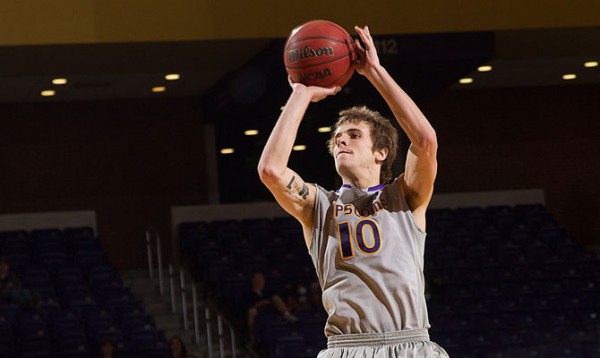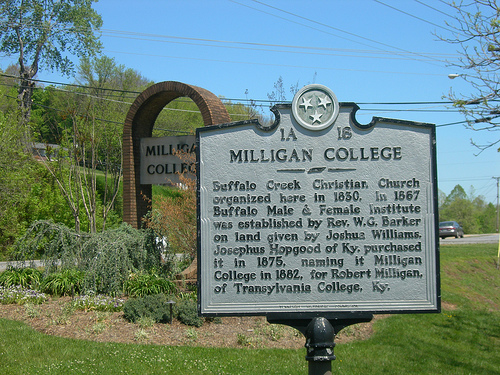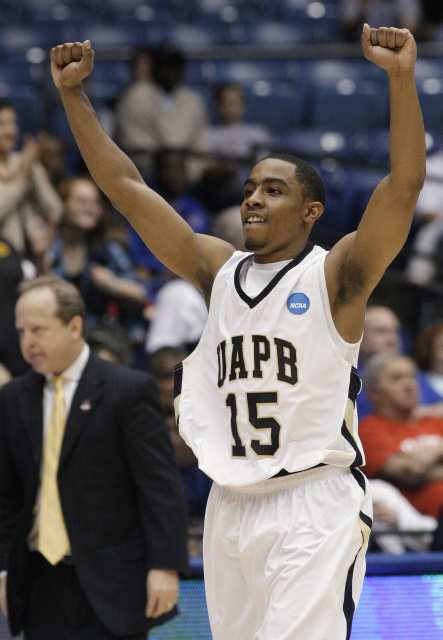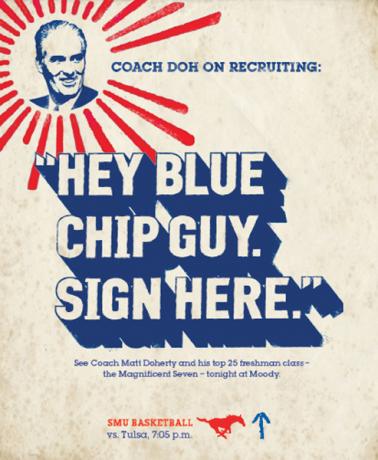
Bucky Dent is the RTC correspondent for the Atlantic Sun Conference. [ed note: this post was written prior to the Nov. 26-28 games]
A Look Back
- Tommy Hubbard Injured: East Tennessee State forward Tommy Hubbard is battling knee problems which have kept him out of two games and hampered him in the only game he played, a Nov. 15 loss at Murray State. While the Buccaneers have enough depth to still field a solid lineup, they don’t want to think about life without Hubbard, their best defensive player and top scorer last year when they won the A-Sun tourney as a five seed. This puts more pressure on Mike Smith, Micah Williams and Justin Tubbs to score the ball without Hubbard‘s presence.
- TV league Upsets: In the first two weeks of the season, A-Sun teams have already scored three attention-grabbing upsets over Power Six foes. Stetson outran and outscored Wake Forest 89-79 Nov. 12, followed by Kennesaw State’s 80-63 whacking of Georgia Tech Nov. 15 (think the Yellow Jackets will ever play in Kennesaw again?). Campbell followed with a 61-54 win at Auburn Nov. 20. One thing all three A-Sun teams have in common: they also lost their next game after those big victories.
- Player of the Week: Lorne Merthie, Campbell – A streaky shooter, Merthie was on during the Camels’ 2-1 showing in a tournament at Auburn, averaging 15.7 points per game. Merthie also picked up four steals against the Tigers, while tallying 22 points and drilling 4-4 three-pointers in a narrow loss to Samford. Just missing the gold medal were Spencer Dixon and Ridge Graham. Dixon‘s 27-point outburst spearheaded Kennesaw State‘s epic drilling of Georgia Tech, while the ultra-athletic Graham went for a 21-point, 12-rebound double-double in the Hatters‘ victory at Wake Forest.
Power Rankings
1. Belmont (3-1)
Next Week: 11/29 at Tennessee State, 12/2 vs. Mercer
This has a chance to be the best team of coach Rick Byrd‘s 25 seasons in Nashville. The Bruins have excellent length and play fundamentally sound defense, forcing teams to take one well-contested shot, then finish the possession with a rebound. The offense is averaging 85.5 ppg in the first four games behind sophomore guard Ian Clark, who would have Dick Vitale screaming his name if he played in a bigger league. Inside, Belmont can count on Mick Hedgepeth and Scott Saunders, who are very productive as long as they can stay out of foul trouble, which isn‘t a given. Point guard Drew Hanlen provides an outrageous 22-to-1 assist-turnover ratio and is a knockdown shooter from the three-point line. Eleven different players are averaging double-figure minutes, making this the league’s deepest and best team as we gird for conference openers next week.
2. East Tennessee State (1-2)
Next Week: 11/27 vs. Milligan, 12/1 at Dayton
When rating teams in this conference, one has to keep the big picture in mind. While the Buccaneers’ record isn’t impressive, consider their losses are at Kentucky and Murray State. Not too many teams anywhere would avoid a sweep in Lexington or Murray. Coach Murry Bartow just wants to weather the December storm (i.e. eight straight road games) and come out of it with his team healthy. The key will be getting Tommy Hubbard back from his knee woes. Mike Smith appears to be 100% after last year‘s injury nightmare, torching Tennessee Tech for an easy 26 points in a 73-60 win Nov. 20. ETSU remains one of the league‘s top defensive teams, doing it with a variety of zones devised by assistant coach Scott Wagers, who basically runs the defense. If it can get reasonable point guard play and get Hubbard healthy, it will challenge for a third straight NCAA Tourney bid.
3. Lipscomb (2-2)
Next week: 11/27 at UT-Martin
Mixed returns so far for the Bisons, which were competitive in losses at major powers North Carolina and Baylor but still aren’t playing good enough defense, allowing opponents to shoot 46.9 percent from the floor and average 82.8 points per game. The good news is Lipscomb’s offense isn’t running at full efficiency yet but is still scoring 83.2 points per game. The 1-2 senior punch of Adnan Hodzic and Josh Slater is performing as one would expect, combining to score nearly 38 PPG. Hodzic has become a better passer out of double-teams early this year and is also hitting 80 percent at the foul line, his career best. Freshman guard Robert Boyd is providing a spark off the bench, averaging 10.5 points and 2.5 steals per game.
4. Jacksonville (3-1)
Next Week: 11/27 at Auburn, 12/2 vs. Stetson
Last year at this time, the Dolphins had overscheduled and were getting blown out on a regular basis, although they bounced back to tie for the regular season title and win a first round NIT game at Arizona State. This year, with a less experienced team and a more reasonable schedule, they‘ve started 3-1. The star player is definitely Ayron Hardy, who, if you were playing A-Sun fantasy basketball (and if you are, you’ve got too much time on your hands), would be your No. 1 overall pick. All he’s done in four games is average 14.3 points, 6.5 rebounds, 4.8 assists, 3.8 steals and 1.8 blocked shots. Besides Hardy’s all-around excellence, Jacksonville is getting much-improved production from sophomore forward Glenn Powell, who’s averaging 12.8 points and hitting 64.5 percent from the field. The defense is allowing just 66.8 ppg and forcing nearly 21 turnovers per game. Don’t sleep on these guys in this league.
5. North Florida: (3-3)
Next Week: 12/2 vs. Florida Gulf Coast
It is a good sign for this program that it‘s 3-3 after a brutal six-game road trip to start the year. Tossing out blowout losses against top-flight programs in Florida State, Pittsburgh and Missouri isn‘t easy, but the Ospreys were impressive on the defensive end in a 59-52 win Nov. 24 against MEAC kingpin Morgan State in Cancun. Sophomore forward Andres Diaz has become more of a scoring threat inside at 11.8 points per game, although he remains a brutal foul shooter at 47.8%. Tennessee State transfer Parker Smith has given this offense-starved squad scoring punch off the bench (11.5 ppg, 38.1 percent 3-pointers). Second-year coach Matt Driscoll, who helped Scott Drew rebuild the Baylor program, has quietly built a nice foundation in his own program.
6. Campbell: (2-3)
Next Week: 11/27 vs. Longwood, 11/29 vs. Johnson C. Smith
With a bunch of new players trying to find roles alongside a veteran backcourt, it might be until January before we know who the Camels are. Guards Lorne Merthie and Junard Hartley supply perimeter scoring punch and excellent defense, in that order. Junior college transfer Eric Griffin is the team‘s leading scorer and rebounded through five games, although he‘s making less than 43% of his shots. The roster‘s remainder is a bunch of decent role players who rarely go above or beyond what they can do. Tune in about six weeks from now and you‘ll know about the Camels.
7. Kennesaw State (2-4)
Next week: 11/26 at Creighton
When their shots are dropping, the Owls can beat anyone, like the ACC‘s Georgia Tech. When they aren’t, they can lose to anyone, like Alabama State, and lose by 40 at mediocre Iowa State. If nothing else, the current four-game losing streak is a reminder that coach Tony Ingle still has a bunch of sophomores who have growing to do at this level. The biggest things Kennesaw State must fix are defense and rebounding. It’s allowing opponents to hit nearly 46 percent from the floor, including 41.2% on 3-pointers, and is being outboarded by nearly four per game. Improvement in those areas might mean not being so shot-dependant.
8. Stetson (1-2)
Next week: 11/26 vs. Palm Beach Atlantic, 11/30 vs. Savannah State, 12/2 at Jacksonville
The win over Wake Forest resonated throughout the conference, but losses to Bethune-Cookman and Central Florida were a reminder that rebuilding remains for the Hatters. With sophomore forward Ridge Graham providing a double-double threat on a nightly basis, this team has a go-to option on the offensive end. Two other sophomores — Tyshawn Patterson and Joel Naburgs — are also scoring in double figures. The down side is the team’s defense, which is allowing opponents to shoot 45% from the field and score nearly 81 points per game. But there is a future for Stetson, as this league will find out a year or two from now.
9. Mercer: (1-3)
Next week: 11/26 vs. Western Carolina (Williamsburg, Va.), 11/27 at William & Mary, 11/28 vs. Gardner-Webb (Williamsburg, Va.), 12/2 at Belmont
Where have you gone, James Florence, Daniel Emerson and E.J. Kusnyer? Without three players which combined for more than 44 points per game last year, the Bears are off to a sub-.500 start which doesn’t look like it will get a lot better. There are a couple of decent weapons in Brandon Moore and Jeff Smith, who are averaging a combined 28.5 ppg. But as a whole, Mercer doesn’t shoot well, especially from three-point range (21-of-90), and isn’t playing well enough on the defensive end (45 percent shooting, 71.2 ppg allowed). The Bears will have to fight just to make the conference tournament on their home floor.
10. Florida Gulf Coast: (2-2)
Next week: 11/27 vs. Miami (Fla.), 12/2 at North Florida
The record looks OK, but the two losses — 88-60 at Indiana and 90-47 at Arkansas — reveal that this team is still second-division material in the A-Sun. Good news is that guard Reed Baker has found his missing shot of a year ago, as he‘s averaging 19.5 ppg and went for 33 in a win at Grambling. But this is still a below-average team offensively (39.6 percent from the floor, 10-of-56 on 3s) and a poor team on defense (49.4 opponents’ field goal percentage, 81.5 ppg). While Ole Miss transfer Kevin Cantinol will help this team get tougher inside when he becomes eligible next month, he probably won’t make the difference between mediocrity and respectability.
11. USC Upstate: (0-6)
Next Week: Nov. 29 vs. UNC Asheville
There have been bright spots, such as the development of freshman forward Torrey Craig, as well as a nine-block shot performance from freshman Babatunde Olumyiwa in a Nov. 23 loss at South Carolina. But the Spartans are easily the conference‘s worst team, one which won‘t be favored in any game it plays this year. Not to pile on too much, but they might be the worst offensive team in America as they are scoring just 51.3 ppg and shooting just 31 percent from the field. Like a minor league baseball team, Upstate should concentrate more on player development and less on the record, although it would love to get that zero out of the win column sometime.
Playing the Percentages
Every week, we’ll look at an intriguing individual or team stat and determine fluke or trend. This week, it’s the three-point accuracy of USC Upstate guard Josh Chavis. A 37.9 percent shooter last year, when he canned ten threes in a game against Florida Gulf Coast, Chavis is colder than Siberia. The 5’9 senior is sinking just 5-of-30 from the arc and is a hideous 5-of-40 overall. We’re saying fluke for now because his career numbers aren’t close to being this bad. Keep on shooting, kid.
A Look Ahead
- Conference play opens up on a limited basis next week. Belmont starts A-Sun play at home with struggling Mercer, which doesn‘t look like a fair fight. Jacksonville welcomes Stetson to town for each team‘s first A-Sun game. Can the Hatters keep their turnovers down against the very athletic Dolphins?
- North Florida finally plays its home opener after six straight away from Jacksonville as it takes on A-Sun rival Florida Gulf Coast.
- East Tennessee State begins a brutal eight-game road trip against a Dayton team which needs every win it can get as it tries to reach the NCAA Tournament. This would be a nice “statement“ game for the Buccaneers.


















































